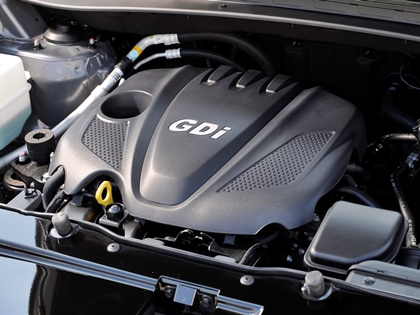Jump back a few years, and Hyundai seemed to have moved from worst to first in fuel economy. Their new cars were managing EPA highway ratings near 40, and they were on track to meet future fuel economy standards ahead of everyone else.
Then the news broke that they had made some iffy assumptions when calculating their EPA figures. The figures were dialed back and previous buyers were compensated.
 For the 2014 model year, the Hyundai Tucson, one of the smallest crossovers you can buy, gets two new direct injected four-cylinder engines. Direct injection costs more, and is more prone to carbon build-up inside the engine, but manufacturers have been transitioning to it because it usually boosts both performance and fuel economy. But the new 2.0-liter engine (slated to make its way into a number of other Hyundai and Kia models, starting with the new Soul), actually makes one fewer horsepower than the engine it replaces, 164 vs. 165. Torque is up a bit, but not by enough to justify DI’s downsides.
For the 2014 model year, the Hyundai Tucson, one of the smallest crossovers you can buy, gets two new direct injected four-cylinder engines. Direct injection costs more, and is more prone to carbon build-up inside the engine, but manufacturers have been transitioning to it because it usually boosts both performance and fuel economy. But the new 2.0-liter engine (slated to make its way into a number of other Hyundai and Kia models, starting with the new Soul), actually makes one fewer horsepower than the engine it replaces, 164 vs. 165. Torque is up a bit, but not by enough to justify DI’s downsides.
And fuel economy? It improves by a single mpg in city driving, and not at all on the highway. EPA ratings of 23/29 continue to rank near the bottom of the segment. The larger Mazda CX-5 manages 25/32 even with its 2.5-liter engine. Add all-wheel-drive, newly available with the smaller engine, and the Tucson’s EPA ratings fall to 21/25, vs. the Mazda’s 24/30.
The 2014 Tucson’s 182-horsepower 2.4-liter engine makes six more horsepower than the engine it replaces, but still eight fewer horsepower than the closely related engine in other Hyundais. Compared to the 2.0 AWD, the highway rating stays the same but the city rating falls to 20. EPA ratings of 20/25 in one of the most compact crossovers with an updated engine? Some large, V6-powered crossovers achieve numbers near these. Nissan’s 260-horsepower Pathfinder scores 19/25, while Acura’s 290-horsepower MDX checks in with 18/27.
I’m baffled.